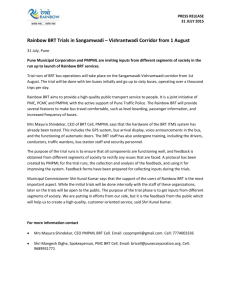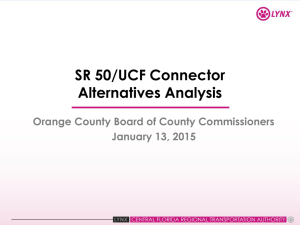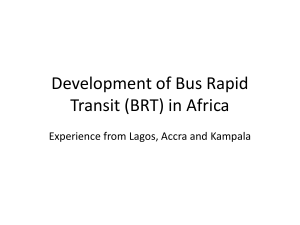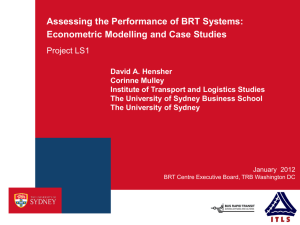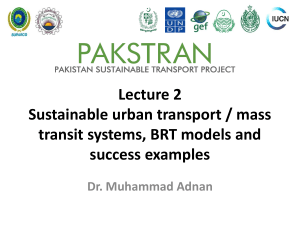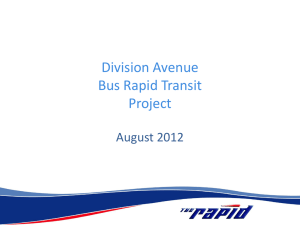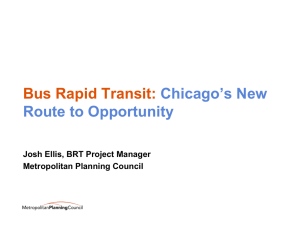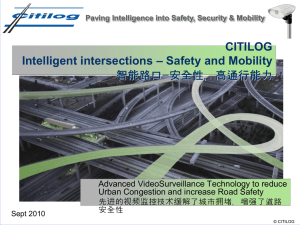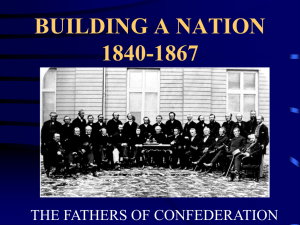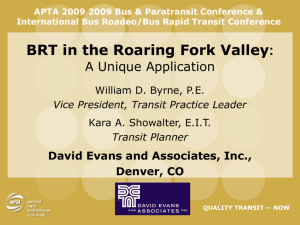Christopher Ziemann - the National Bus Rapid Transit Institute
advertisement
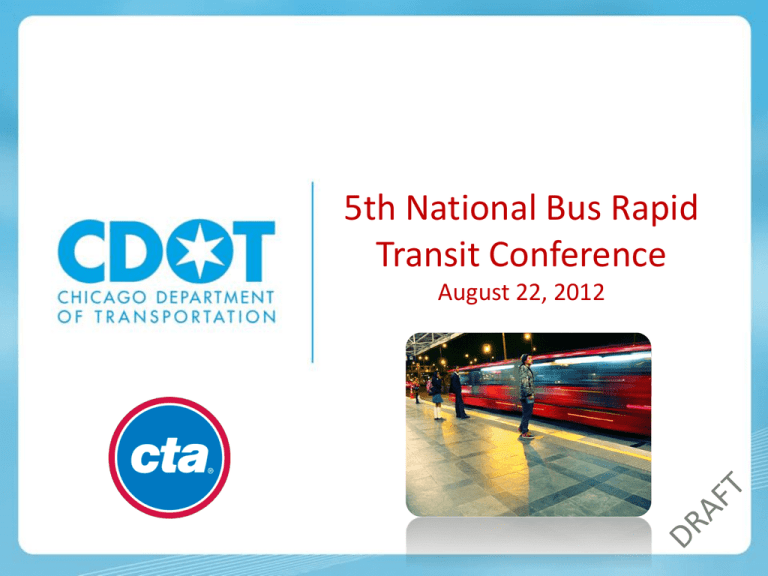
5th National Bus Rapid Transit Conference August 22, 2012 Christopher Ziemann Chicago BRT Project Manager Position funded through a grant to the Chicago Community Trust from the Rockefeller Foundation Jointly split between Chicago Department of Transportation and Chicago Transit Authority Responsible for coordinating and developing the Chicago BRT System Formerly Consultant at the World Bank Researcher in the Institute for Transportation and Development Policy Transportation Planner in Washington, DC Intern in Curitiba, Brazil Special Thanks With support from The BRT Standard Purpose of BRT Standard Evaluate existing systems Evaluate systems in the planning phase Gold, Silver, and Bronze Standards BRT Standard Committee Walter Hook, ITDP Lloyd Wright, Asian Development Bank* Dario Hidalgo, EMBARQ* Gerhard Menckhoff, World Bank (retired), ITDP Vice President Wagner Colombini Martins, Logit Consultoria Carlos Felipe Pardo, Slow Research Pedro Szasz, Consultant Ulises Navarro, Modelistica Scott Rutherford, University of Washington Avaliable at www.itdp.org Chicago’s Approach to BRT Goals Grow ridership on the bus network Eliminate Bus Slow Zones Forward Compatible Investment Implement Complete Streets Short-Term Improvements Targeted bus lanes Transit Signal Priority Test BRT elements on Jeffery corridor Implement full BRT in the Loop Long-Term Vision Develop citywide BRT plan Phased implementation Short-term modular improvements Develop branded services Concept of third mode ‘L’, Bus, and BRT 5 Benefits of BRT in Chicago Riders 26% of Chicago households car-less Complete Streets Speed and Reliability Especially important for hourly workers Customer experience Neighborhood-focused Efficient Use of Funds - Modular and incremental investments Funding flexibility Focus on pinch points Steady investment Efficient Operations Lower Cost Minimum service standards Speed and reliability 6 Challenges of BRT in Chicago Roadway Trade-offs Bus-only lanes Parking and loading Station spacing (1/2 v. 1/8th mile) Turn restrictions Potential for traffic to residential streets Political / Community Routes cross aldermanic wards (50) Potential for compromise Rumors of different fare 7 Chicago BRT Steering Committee Group of Civic Non-Profit Partners Financial and administrative support Outreach Connections to land use and real estate Connections with other foundations Pro bono consulting work Education Design Technical assistance Political support Branding System Branding Develop brand standards Hours of operation Frequency Minimum speed and reliability Design standards Amenities Develop design standards Logo and color Messaging Jeffery Branding Currently for Jeffery only Expand brand to BRT system Keep tiered system 9 Communications Strategic Communications Plan Six key messages Organize communications Communication roles Outreach - Non-profit partners Aldermen Neighborhood Organizations Chambers of Commerce Website www.BRTChicago.com Focus Groups Test Messaging and Branding Jeffery Blvd – Piloting BRT Elements Piloting BRT Elements Project Need Faster, more reliable service express route Status Construction beginning any day now Funding $11 million FTA Bus and Bus Facilities (5309) grant Schedule Operations will likely begin in November Key BRT Elements to Pilot: Rush Hour Bus Lanes Transit Signal Priority (TSP) Bus queue jump Unique branding Internal LED Bus Tracker screens New and upgraded bus shelters New street furniture and signage 11 Jeffery Pilot Route and Time Savings 12 Central Loop BRT Union Station to Navy Pier Project Need High-quality transit through downtown Connect Union Station to Navy Pier Status Under design Funding Sources $24.6M Federal Grant (Urban Circulator) $4.7 M Federal Grant (CMAQ for terminal) $7.3 M in TIF Schedule Complete design in 2013 Construct in 2014 Key Elements Dedicated bus lanes Colored pavement Boarding Platforms New off-street bus terminal at Union Station Used by 6 different bus lines Branding issues 13 Downtown Traffic Stats Over half of people on Washington and Madison Walk Of those in vehicles, nearly half are on the bus Buses make up only 4% of vehicles BRT could reduce bus-related crashes by over 50% 14 Net average user benefit (47% Bus; 51% Car/Taxi) Option 1: +1.41 min Option 2: +2.76 min Option 3: +3.11 min (slower) Travel Minutes Saved (faster) Central Loop: Total round-trip travel time benefit 15 Western/Ashland Corridors BRT Project Needs Improve Service on High Ridership Corridor Improve non-downtown connectivity Status Alternatives Analysis Screen 2 Funding Sources $1.6 Million FTA Bus Livability Alternatives Analysis Schedule Alternatives Analysis through 2012 Future phases dependent on funding availability Key Elements 21-mile corridors on Western and Ashland Options for near-term improvements Wide ROW provides opportunity for substantial improvements 16 Western/Ashland Corridors BRT 17 Next Phase System Network Plan Network of BRT lines Implementation Plan Phasing Incremental investment plan Financial plan Outreach Plan Coordinated with other localized projects Outreach Expand current outreach city-wide Expand use of pop-up meetings Civic Advisory Council Include other business and civic leaders Land Use Strategy Promote TOD growth around future BRT stations Stay In Touch Christopher Ziemann, AICP Chicago BRT Project Manager cziemann@transitchicago.com CTA: 312-681-4289 CDOT: 312-744-8251 Cell: 919-360-8581 Website www.BRTChicago.com Twitter #BRTChicago CTA www.transitchicago.com CDOT www.chicagodot.org 19
